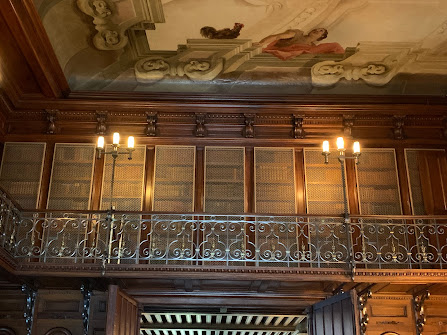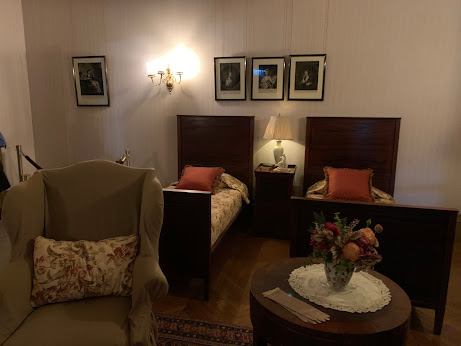As we continued east, we planned a two day stop near Asheville so we could visit Biltmore.
We made reservations and were at the estate early (if I'm on time I'm late) and found our way to the parking area and climbed aboard the shuttle to take us to the house.
The driver was great and told us about the landscaping and how it was designed to create anticipation for visitors as they approached the home. And at just the precise moment, he described the culmination of the drive in and the "awe" factor as the home came into view. And there it was!
In the 1880s, George Vanderbilt began to make regular visits to the Asheville area. He loved the scenery and climate so decided to build a summer house, which he called his "little mountain escape." Wonder what his winter house looked like. Haha. He named his estate Biltmore, combining De Bilt (his ancestors' place of origin in the Netherlands) with more (an open, rolling land). He bought nearly 700 parcels of land, including over 50 farms and at least five cemeteries. A portion of the estate was once the community of Shiloh.
Since we had plenty of time, we wandered through the courtyard and shops. Restoration on the bricks was underway.
And then on to the shops. Everything was beautiful.
And then it was on to the main event. Entry into the house was very organized. Only a few visitors are allowed in at a time.
After entry, guests make a stop in this beautiful atrium to collect a hand held device that leads you through the house and explains the details of each room.
Construction of the house began in 1889. In order to make this large project possible, a woodworking factory and brick kiln, which produced 32,000 bricks per day, were built onsite. A three mile railroad spur was constructed to bring materials to the building site. Construction on the house required the labor of about 1,000 workers and 60 stonemasons.
George Vanderbilt opened the estate on Christmas Eve, 1895 to family and friends from across the country. The mansion reportedly cost $5 million ($180 million today) to construct. George married Edith Stuyvesant Dresser in 1898 and their only child, Cornelia, was born at Biltmore in 1900 and grew up at the estate.
Houseguests played dominoes and billiards and enjoyed refreshments in this richly paneled room. The custom oak billiard tables were made in 1895.
Billiard cues
This was the viewing area so that those not playing could watch the games in comfort.
The banquet hall has a seven story high ceiling and tapestries from the mid 1500s. Guests of the Vanderbilts enjoyed elegant dinners that began promptly at 8 p.m. Often the highlight of a stay at Biltmore, these elaborate, ceremonious affairs featured up to 10 courses and as many as five different wine pairings and live musical entertainment.
Guests of the Vanderbilts were served both breakfast and luncheon in the Breakfast Room. The two small paintings on the right are by French Impressionist Pierre Auguste Renoir.
The Music Room was not finished during George Vanderbilt's time - it wasn't finished until 1976.
In 1941 during World War II, American leaders based in the nation's capital began to fear the possibility of an attack. German submarines had been sighted along the Atlantic Coast from Maine to North Carolina, bringing the war uncomfortably close to the American shore. With that in mind, and with information from European sources about Hitler's efforts to seize and stockpile art, the director of the National Gallery of Art in Washington D.C. contacted Biltmore to discuss the possibility of sending some of the nation's most important art treasures there for safekeeping.
The unfinished Music Room was refitted with steel doors and other protective measures were taken, as outlined by the National Gallery of Art. On January 8, 1942, an array of guests arrived at the house. Accompanied by guards on their journey from Washington D.C., 62 paintings and 17 sculptures from the National Gallery of Art were carried into the house and placed in the Music Room for safekeeping. Biltmore had opened to the public in 1930 as a means of promoting tourism in Asheville. Guests walked by the Music Room, unaware that some of the world's greatest artwork was secretly hidden on the other side of the wall. The priceless artwork remained under 24 hour armed guard until the fall of 1944, well after the danger of bombings or invasion had ended.
The shelves are so high that a staircase is needed to reach the highest books.
Hard to appreciate the beauty of The Chariot of Aurora on the ceiling. This was painted in the 1720s by Italian artist Giovanni Pellegrini.
At 90 feet in length the Tapestry Gallery is the longest room in the house. Painted limestone mantels above each fireplace divides the room visually into thirds, with each third devoted to one of the three tapestries Vanderbilt acquired from an original set of seven known as The Triumph of the Seven Virtues.
This sitting room was located between the family's bedrooms and functioned as a private sitting area for the Vanderbilt's to relax, plan their day, and host close friends. It also served as a gallery where George showcased his prized collections.
This room was named for James Watson and is part of a suite of rooms named for artists whose works are displayed. It is the only bedroom with twin beds.
Those in the 'guest retreats' came to the Third Floor Living Hall to read, listen to music, and unwind. Notable furnishings include Herter Brothers display cabinets and bookcases inherited by George Vanderbilt from his father's home in New York City.
We headed down the Grand Staircase.....
To the recreation area and basement.
This stone hallway shows one of the foundation walls. It took almost two years to build the foundations and footings that extend down about 29 feet.
It was not proper to walk through the house with swim wear on so these dressing rooms were used by female guests to change into the appropriate clothing.
The 70,000 gallon indoor pool was heated and still has its original underwater lighting. When preparing for a party at the end of the 20th century, the pool was filled so that guests could enjoy it. Unfortunately, over night the pool completely drained into the lower floors and it hasn't been used since.
Biltmore's gardens and grounds offered a wide range of leisurely outdoor activities including horseback riding, fishing, and playing croquet. The estate even had its own golf course during the Vanderbilt's era.
Biltmore functioned like a luxury hotel, requiring an exceptional staff to ensure day-to-day operations ran smoothly. Employees received room, board, and uniforms as well as pay that was higher than the Asheville standard.
Up to 30 domestic staff members worked in Biltmore House under the supervision of the head housekeeper, who ran the daily operations, and the head butler, who oversaw the male staff including footmen and houseboys. The servants gathered together in this dining room for meals.
An example of a bedroom utilized by the servants.
There were a number of pantries and walk-in refrigerators. It's not often that you see a pantry dedicated just to plants.
The Main Laundry was as busy and well-equipped as one in large hotel, with laundresses working into the evening to wash and dry bed, bath, and table linens. Ron's grandfather owned a large industrial laundry in Winnemucca, Nevada and later in Mt. View, California so this brought back some memories.
And the bachelors had their own wing. In the Smoking Room, the male guests enjoyed after dinner cigars, pipes, and brandy.
Hunting parties were a popular pastime on country estates. Guests selected guns from George Vanderbilt's collection to use on their excursions.
What an incredible home but we weren't finished yet. We still had the gardens and other parts of the estate to visit. That's the next episode.





















































I'm exhausted! This reminds me somewhat of touring Schonbrunn Palace in Vienna, Austria. So opulent. So much to take in that you almost can't see it all. And then your mind goes spinning trying to imagine who planned it all, who maintains it all, what was it like to actually live there day to day.
ReplyDeleteI was exhausted seeing it - and writing about it. And we still had the gardens and other sites to see.
Delete